Women's Knowledge of Cervical Smear Tests: Ranjitha Babu, 2018-2019
VerifiedAdded on 2022/11/28
|56
|13370
|489
Thesis and Dissertation
AI Summary
This M.Sc. Nursing thesis by Ranjitha Babu from the University of Limerick (2018-2019) investigates women's knowledge of cervical smear tests. The research explores the background of cervical cancer, its global prevalence, and the importance of early detection through screening. The thesis details the methodology used, including literature review strategies, database selection, and search terms. Findings highlight factors influencing women's knowledge, including a lack of awareness, fear of the procedure, and the influence of doctors. The study examines the impact of these factors on screening uptake. The thesis concludes with a discussion of the implications of these findings, emphasizing the need for increased awareness and education to improve women's health outcomes related to cervical cancer. The thesis also includes an acknowledgement section, and a table of contents. The research emphasizes the importance of public health programs and the need to address barriers to cervical cancer screening.
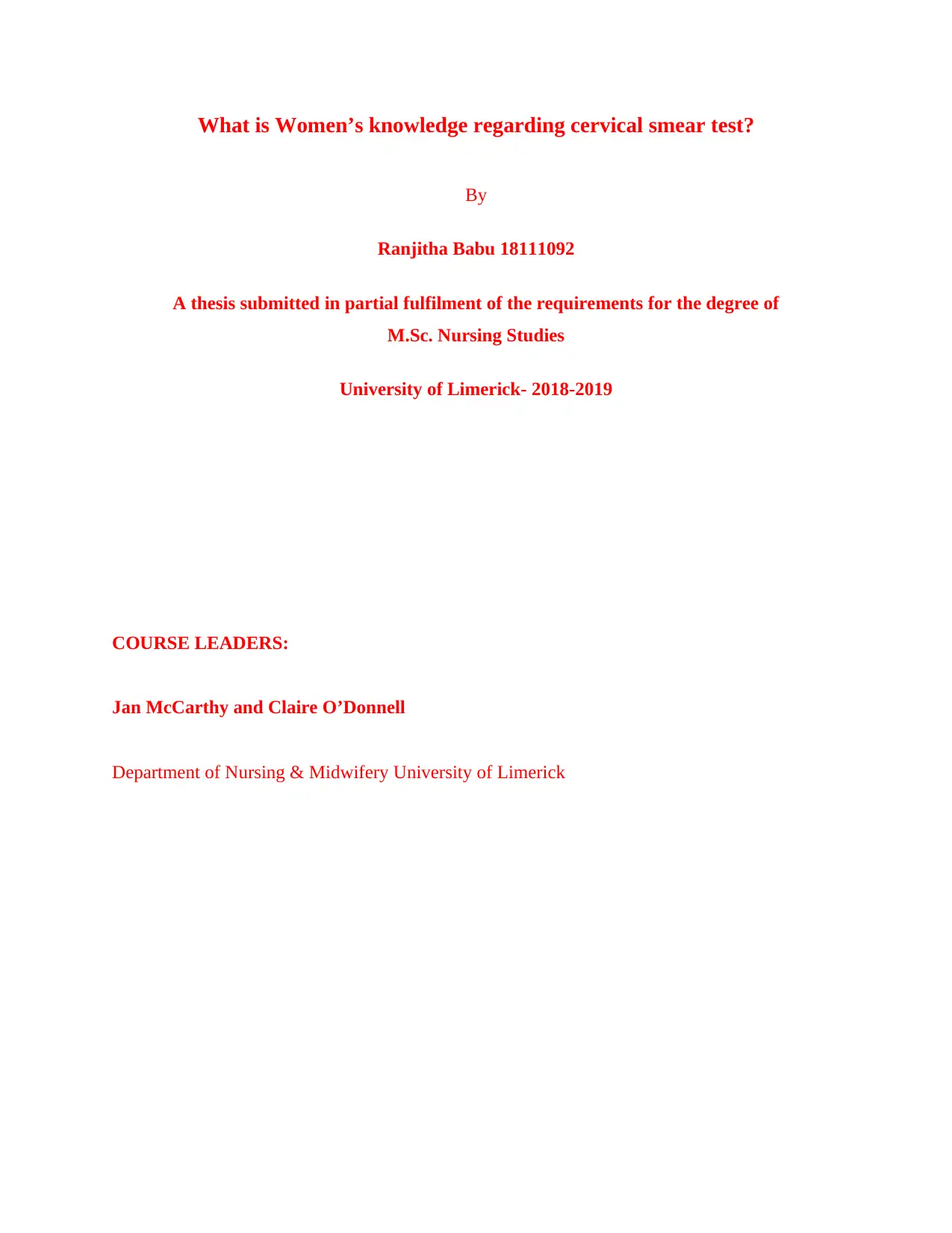
What is Women’s knowledge regarding cervical smear test?
By
Ranjitha Babu 18111092
A thesis submitted in partial fulfilment of the requirements for the degree of
M.Sc. Nursing Studies
University of Limerick- 2018-2019
COURSE LEADERS:
Jan McCarthy and Claire O’Donnell
Department of Nursing & Midwifery University of Limerick
By
Ranjitha Babu 18111092
A thesis submitted in partial fulfilment of the requirements for the degree of
M.Sc. Nursing Studies
University of Limerick- 2018-2019
COURSE LEADERS:
Jan McCarthy and Claire O’Donnell
Department of Nursing & Midwifery University of Limerick
Paraphrase This Document
Need a fresh take? Get an instant paraphrase of this document with our AI Paraphraser

Sample Declaration of Authorship
I, the undersigned declare that this dissertation which I am submitting is all my own work.
Print Name: RanjithaBabu ID: 18111092
Signature: ________________
Date: 16 / 07 /19
I, the undersigned declare that this dissertation which I am submitting is all my own work.
Print Name: RanjithaBabu ID: 18111092
Signature: ________________
Date: 16 / 07 /19

⊘ This is a preview!⊘
Do you want full access?
Subscribe today to unlock all pages.

Trusted by 1+ million students worldwide

ACKNOWLEDGMENT
I would first like to thank my thesis advisor Jan McCarthy of the department
of Nursing at the University of Limerick. The door to her office was always
open whenever I ran into a trouble or had a question about my thesis or
writing. She consistently allowed this paper to be my own work and steered
me in the right direction whenever she thought I needed it.
I would also like to acknowledge Claire O Donnel of the department of
Nursing at the University of Limerick. Her smile and positive words inspired
and motivated me throughout the period of course. I am also gratefully
indebted to her for her very valuable comments on this thesis.
I would also like to thank my friends for the stimulating discussions, for the
sleepless nights we were working together before deadlines, and for all the
fun we have had in the last one year.
Last but not the least, I would like to thank my family: my parents and to my
sister for supporting me spiritually throughout writing this thesis and my life
in general.
I would first like to thank my thesis advisor Jan McCarthy of the department
of Nursing at the University of Limerick. The door to her office was always
open whenever I ran into a trouble or had a question about my thesis or
writing. She consistently allowed this paper to be my own work and steered
me in the right direction whenever she thought I needed it.
I would also like to acknowledge Claire O Donnel of the department of
Nursing at the University of Limerick. Her smile and positive words inspired
and motivated me throughout the period of course. I am also gratefully
indebted to her for her very valuable comments on this thesis.
I would also like to thank my friends for the stimulating discussions, for the
sleepless nights we were working together before deadlines, and for all the
fun we have had in the last one year.
Last but not the least, I would like to thank my family: my parents and to my
sister for supporting me spiritually throughout writing this thesis and my life
in general.
Paraphrase This Document
Need a fresh take? Get an instant paraphrase of this document with our AI Paraphraser
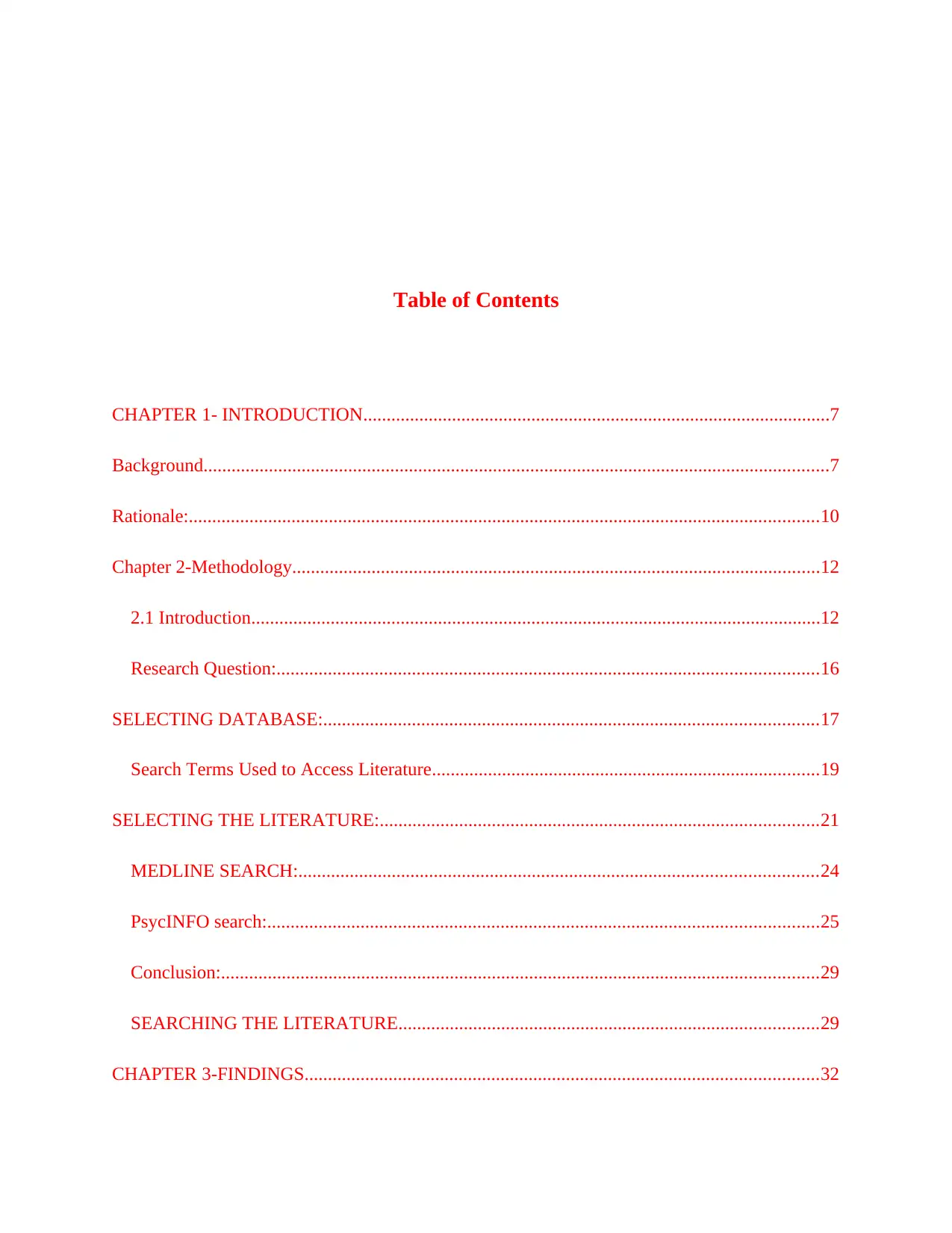
Table of Contents
CHAPTER 1- INTRODUCTION....................................................................................................7
Background......................................................................................................................................7
Rationale:.......................................................................................................................................10
Chapter 2-Methodology.................................................................................................................12
2.1 Introduction..........................................................................................................................12
Research Question:....................................................................................................................16
SELECTING DATABASE:..........................................................................................................17
Search Terms Used to Access Literature...................................................................................19
SELECTING THE LITERATURE:..............................................................................................21
MEDLINE SEARCH:...............................................................................................................24
PsycINFO search:......................................................................................................................25
Conclusion:................................................................................................................................29
SEARCHING THE LITERATURE..........................................................................................29
CHAPTER 3-FINDINGS..............................................................................................................32
CHAPTER 1- INTRODUCTION....................................................................................................7
Background......................................................................................................................................7
Rationale:.......................................................................................................................................10
Chapter 2-Methodology.................................................................................................................12
2.1 Introduction..........................................................................................................................12
Research Question:....................................................................................................................16
SELECTING DATABASE:..........................................................................................................17
Search Terms Used to Access Literature...................................................................................19
SELECTING THE LITERATURE:..............................................................................................21
MEDLINE SEARCH:...............................................................................................................24
PsycINFO search:......................................................................................................................25
Conclusion:................................................................................................................................29
SEARCHING THE LITERATURE..........................................................................................29
CHAPTER 3-FINDINGS..............................................................................................................32
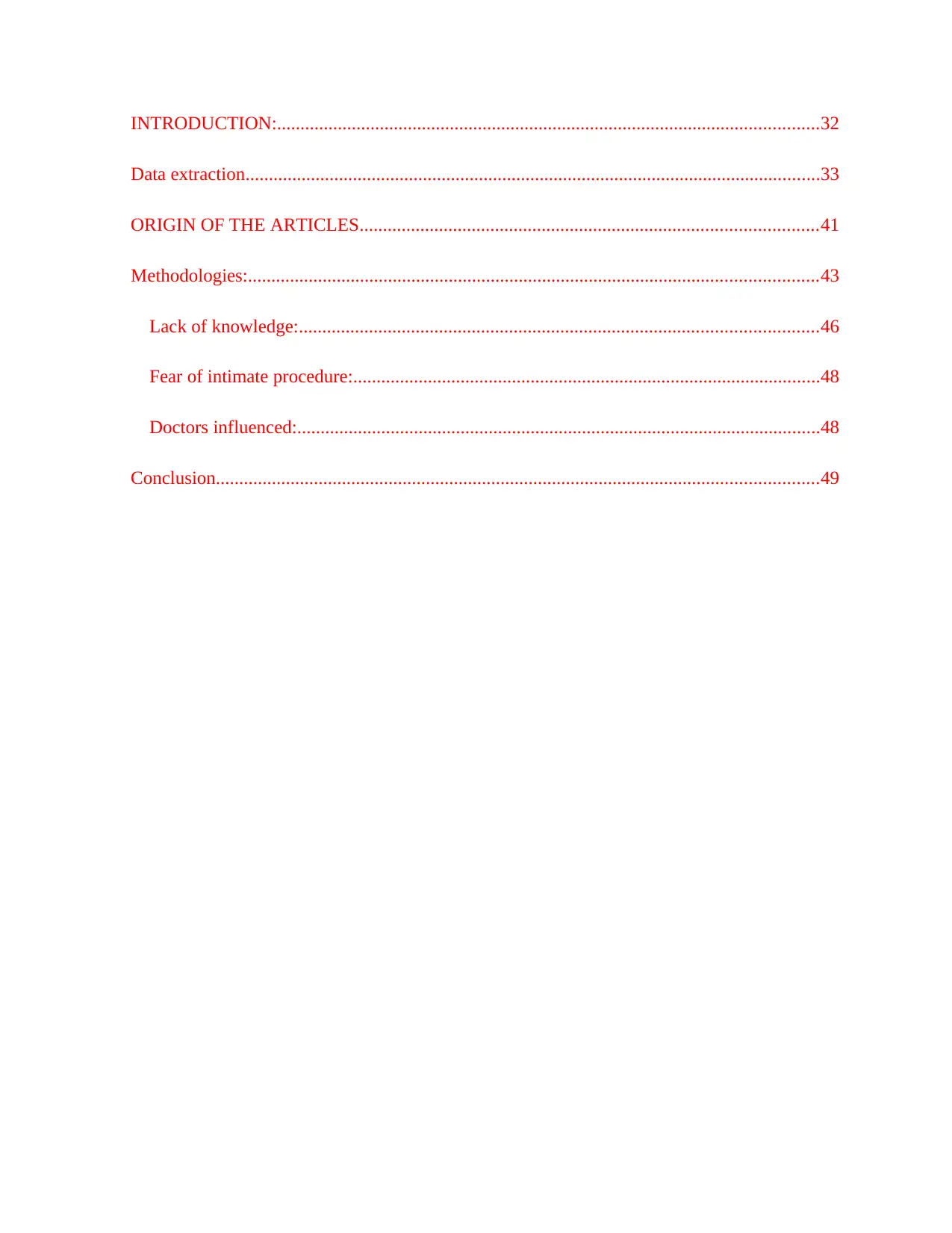
INTRODUCTION:....................................................................................................................32
Data extraction...........................................................................................................................33
ORIGIN OF THE ARTICLES..................................................................................................41
Methodologies:..........................................................................................................................43
Lack of knowledge:...............................................................................................................46
Fear of intimate procedure:....................................................................................................48
Doctors influenced:................................................................................................................48
Conclusion.................................................................................................................................49
Data extraction...........................................................................................................................33
ORIGIN OF THE ARTICLES..................................................................................................41
Methodologies:..........................................................................................................................43
Lack of knowledge:...............................................................................................................46
Fear of intimate procedure:....................................................................................................48
Doctors influenced:................................................................................................................48
Conclusion.................................................................................................................................49
⊘ This is a preview!⊘
Do you want full access?
Subscribe today to unlock all pages.

Trusted by 1+ million students worldwide
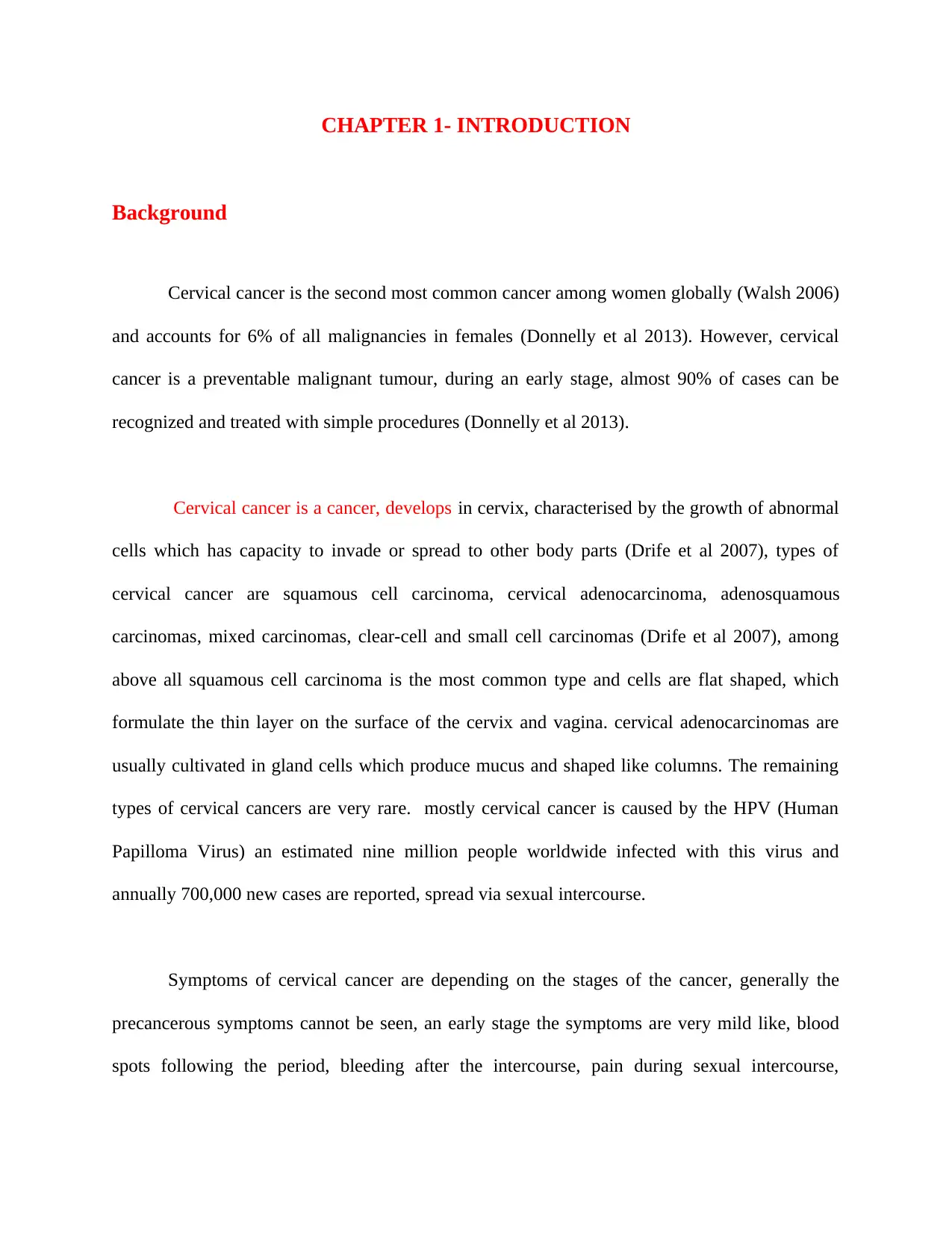
CHAPTER 1- INTRODUCTION
Background
Cervical cancer is the second most common cancer among women globally (Walsh 2006)
and accounts for 6% of all malignancies in females (Donnelly et al 2013). However, cervical
cancer is a preventable malignant tumour, during an early stage, almost 90% of cases can be
recognized and treated with simple procedures (Donnelly et al 2013).
Cervical cancer is a cancer, develops in cervix, characterised by the growth of abnormal
cells which has capacity to invade or spread to other body parts (Drife et al 2007), types of
cervical cancer are squamous cell carcinoma, cervical adenocarcinoma, adenosquamous
carcinomas, mixed carcinomas, clear-cell and small cell carcinomas (Drife et al 2007), among
above all squamous cell carcinoma is the most common type and cells are flat shaped, which
formulate the thin layer on the surface of the cervix and vagina. cervical adenocarcinomas are
usually cultivated in gland cells which produce mucus and shaped like columns. The remaining
types of cervical cancers are very rare. mostly cervical cancer is caused by the HPV (Human
Papilloma Virus) an estimated nine million people worldwide infected with this virus and
annually 700,000 new cases are reported, spread via sexual intercourse.
Symptoms of cervical cancer are depending on the stages of the cancer, generally the
precancerous symptoms cannot be seen, an early stage the symptoms are very mild like, blood
spots following the period, bleeding after the intercourse, pain during sexual intercourse,
Background
Cervical cancer is the second most common cancer among women globally (Walsh 2006)
and accounts for 6% of all malignancies in females (Donnelly et al 2013). However, cervical
cancer is a preventable malignant tumour, during an early stage, almost 90% of cases can be
recognized and treated with simple procedures (Donnelly et al 2013).
Cervical cancer is a cancer, develops in cervix, characterised by the growth of abnormal
cells which has capacity to invade or spread to other body parts (Drife et al 2007), types of
cervical cancer are squamous cell carcinoma, cervical adenocarcinoma, adenosquamous
carcinomas, mixed carcinomas, clear-cell and small cell carcinomas (Drife et al 2007), among
above all squamous cell carcinoma is the most common type and cells are flat shaped, which
formulate the thin layer on the surface of the cervix and vagina. cervical adenocarcinomas are
usually cultivated in gland cells which produce mucus and shaped like columns. The remaining
types of cervical cancers are very rare. mostly cervical cancer is caused by the HPV (Human
Papilloma Virus) an estimated nine million people worldwide infected with this virus and
annually 700,000 new cases are reported, spread via sexual intercourse.
Symptoms of cervical cancer are depending on the stages of the cancer, generally the
precancerous symptoms cannot be seen, an early stage the symptoms are very mild like, blood
spots following the period, bleeding after the intercourse, pain during sexual intercourse,
Paraphrase This Document
Need a fresh take? Get an instant paraphrase of this document with our AI Paraphraser
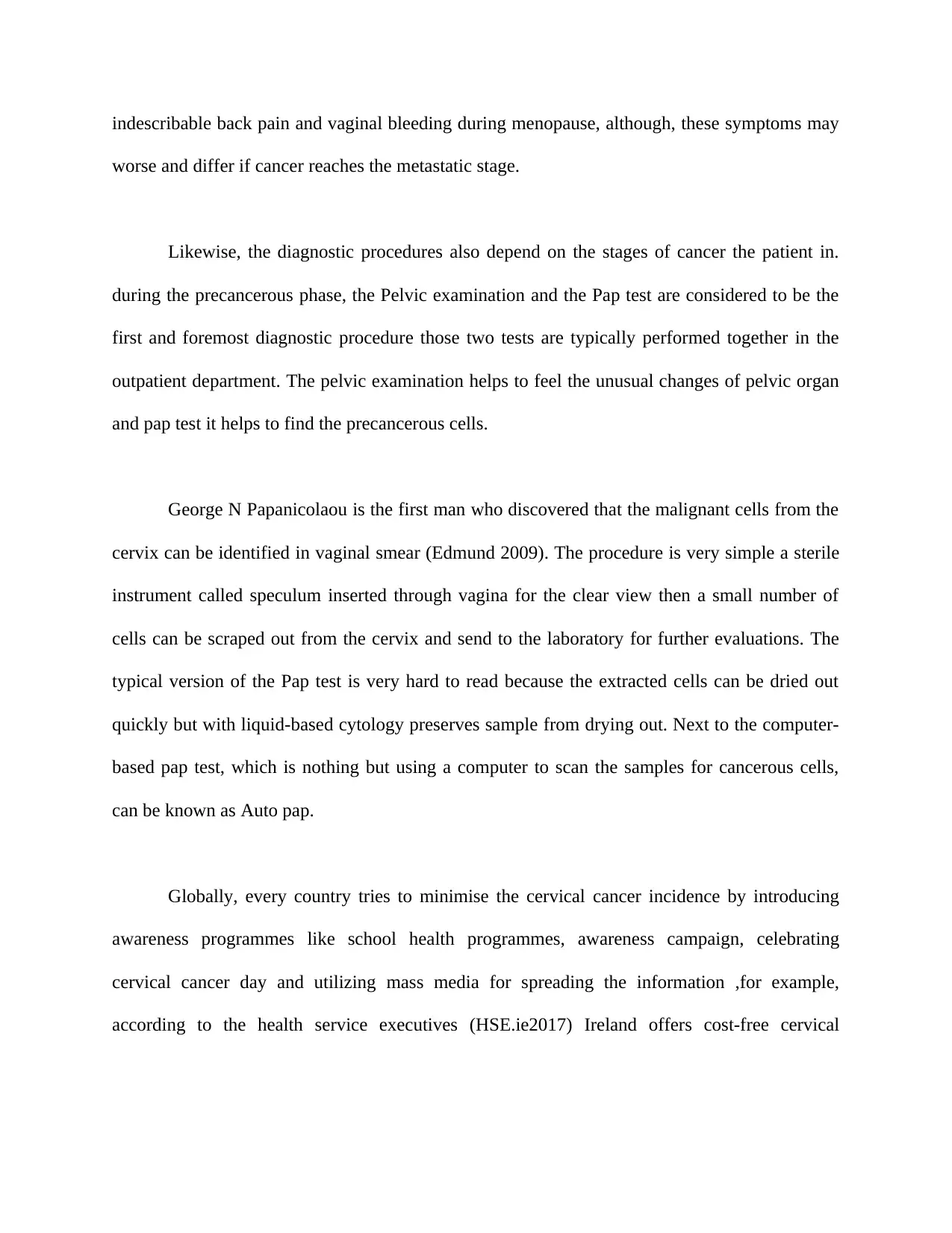
indescribable back pain and vaginal bleeding during menopause, although, these symptoms may
worse and differ if cancer reaches the metastatic stage.
Likewise, the diagnostic procedures also depend on the stages of cancer the patient in.
during the precancerous phase, the Pelvic examination and the Pap test are considered to be the
first and foremost diagnostic procedure those two tests are typically performed together in the
outpatient department. The pelvic examination helps to feel the unusual changes of pelvic organ
and pap test it helps to find the precancerous cells.
George N Papanicolaou is the first man who discovered that the malignant cells from the
cervix can be identified in vaginal smear (Edmund 2009). The procedure is very simple a sterile
instrument called speculum inserted through vagina for the clear view then a small number of
cells can be scraped out from the cervix and send to the laboratory for further evaluations. The
typical version of the Pap test is very hard to read because the extracted cells can be dried out
quickly but with liquid-based cytology preserves sample from drying out. Next to the computer-
based pap test, which is nothing but using a computer to scan the samples for cancerous cells,
can be known as Auto pap.
Globally, every country tries to minimise the cervical cancer incidence by introducing
awareness programmes like school health programmes, awareness campaign, celebrating
cervical cancer day and utilizing mass media for spreading the information ,for example,
according to the health service executives (HSE.ie2017) Ireland offers cost-free cervical
worse and differ if cancer reaches the metastatic stage.
Likewise, the diagnostic procedures also depend on the stages of cancer the patient in.
during the precancerous phase, the Pelvic examination and the Pap test are considered to be the
first and foremost diagnostic procedure those two tests are typically performed together in the
outpatient department. The pelvic examination helps to feel the unusual changes of pelvic organ
and pap test it helps to find the precancerous cells.
George N Papanicolaou is the first man who discovered that the malignant cells from the
cervix can be identified in vaginal smear (Edmund 2009). The procedure is very simple a sterile
instrument called speculum inserted through vagina for the clear view then a small number of
cells can be scraped out from the cervix and send to the laboratory for further evaluations. The
typical version of the Pap test is very hard to read because the extracted cells can be dried out
quickly but with liquid-based cytology preserves sample from drying out. Next to the computer-
based pap test, which is nothing but using a computer to scan the samples for cancerous cells,
can be known as Auto pap.
Globally, every country tries to minimise the cervical cancer incidence by introducing
awareness programmes like school health programmes, awareness campaign, celebrating
cervical cancer day and utilizing mass media for spreading the information ,for example,
according to the health service executives (HSE.ie2017) Ireland offers cost-free cervical
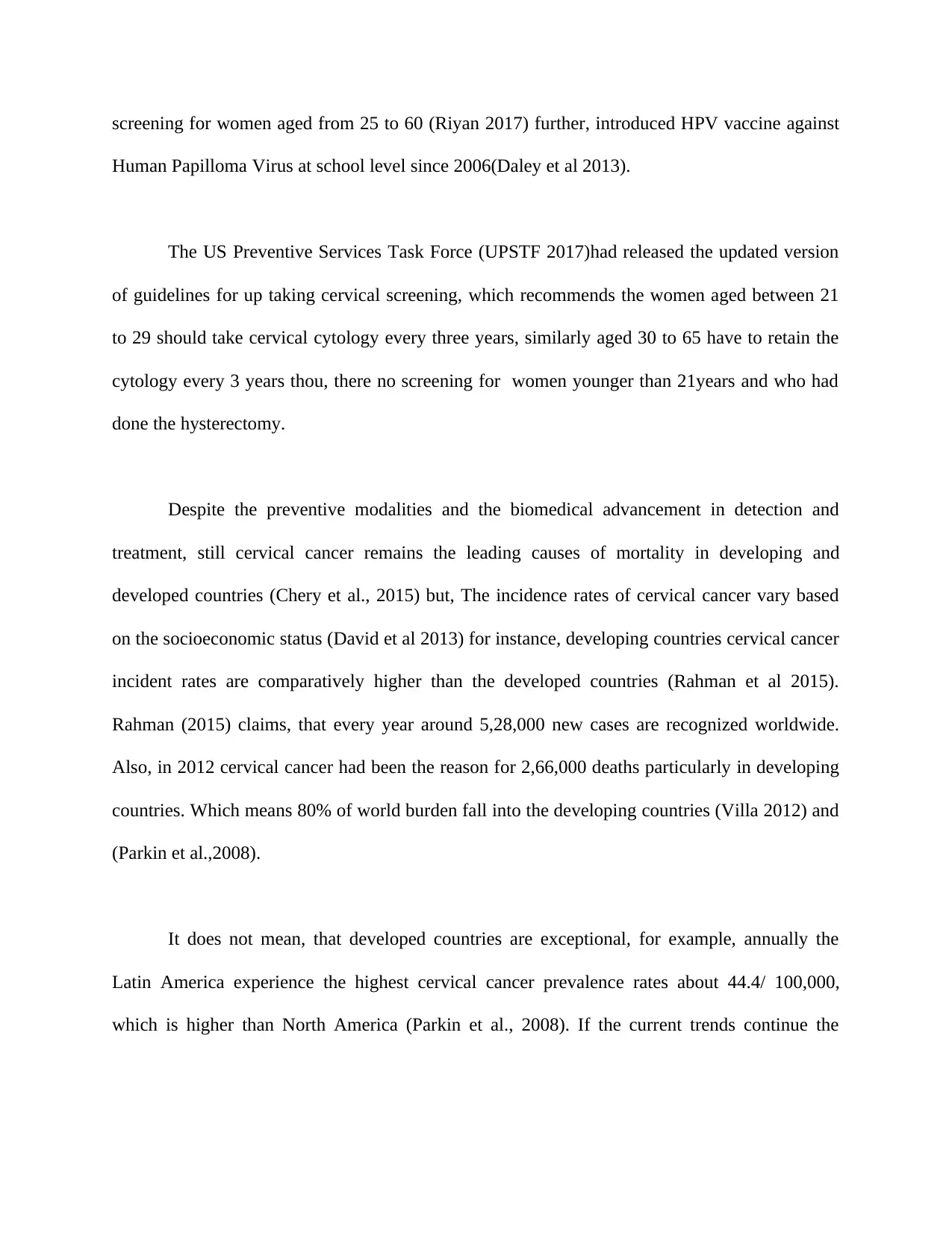
screening for women aged from 25 to 60 (Riyan 2017) further, introduced HPV vaccine against
Human Papilloma Virus at school level since 2006(Daley et al 2013).
The US Preventive Services Task Force (UPSTF 2017)had released the updated version
of guidelines for up taking cervical screening, which recommends the women aged between 21
to 29 should take cervical cytology every three years, similarly aged 30 to 65 have to retain the
cytology every 3 years thou, there no screening for women younger than 21years and who had
done the hysterectomy.
Despite the preventive modalities and the biomedical advancement in detection and
treatment, still cervical cancer remains the leading causes of mortality in developing and
developed countries (Chery et al., 2015) but, The incidence rates of cervical cancer vary based
on the socioeconomic status (David et al 2013) for instance, developing countries cervical cancer
incident rates are comparatively higher than the developed countries (Rahman et al 2015).
Rahman (2015) claims, that every year around 5,28,000 new cases are recognized worldwide.
Also, in 2012 cervical cancer had been the reason for 2,66,000 deaths particularly in developing
countries. Which means 80% of world burden fall into the developing countries (Villa 2012) and
(Parkin et al.,2008).
It does not mean, that developed countries are exceptional, for example, annually the
Latin America experience the highest cervical cancer prevalence rates about 44.4/ 100,000,
which is higher than North America (Parkin et al., 2008). If the current trends continue the
Human Papilloma Virus at school level since 2006(Daley et al 2013).
The US Preventive Services Task Force (UPSTF 2017)had released the updated version
of guidelines for up taking cervical screening, which recommends the women aged between 21
to 29 should take cervical cytology every three years, similarly aged 30 to 65 have to retain the
cytology every 3 years thou, there no screening for women younger than 21years and who had
done the hysterectomy.
Despite the preventive modalities and the biomedical advancement in detection and
treatment, still cervical cancer remains the leading causes of mortality in developing and
developed countries (Chery et al., 2015) but, The incidence rates of cervical cancer vary based
on the socioeconomic status (David et al 2013) for instance, developing countries cervical cancer
incident rates are comparatively higher than the developed countries (Rahman et al 2015).
Rahman (2015) claims, that every year around 5,28,000 new cases are recognized worldwide.
Also, in 2012 cervical cancer had been the reason for 2,66,000 deaths particularly in developing
countries. Which means 80% of world burden fall into the developing countries (Villa 2012) and
(Parkin et al.,2008).
It does not mean, that developed countries are exceptional, for example, annually the
Latin America experience the highest cervical cancer prevalence rates about 44.4/ 100,000,
which is higher than North America (Parkin et al., 2008). If the current trends continue the
⊘ This is a preview!⊘
Do you want full access?
Subscribe today to unlock all pages.

Trusted by 1+ million students worldwide
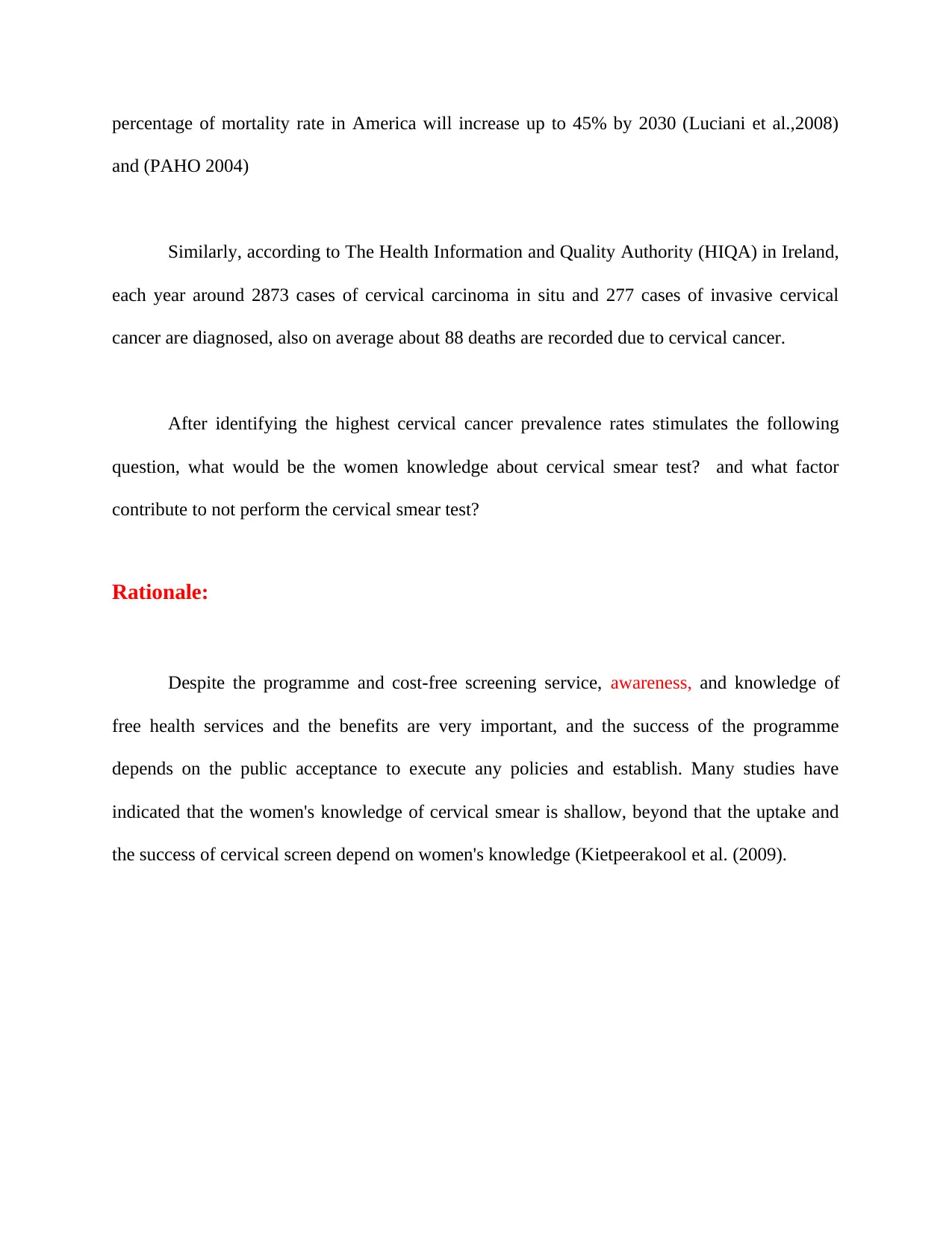
percentage of mortality rate in America will increase up to 45% by 2030 (Luciani et al.,2008)
and (PAHO 2004)
Similarly, according to The Health Information and Quality Authority (HIQA) in Ireland,
each year around 2873 cases of cervical carcinoma in situ and 277 cases of invasive cervical
cancer are diagnosed, also on average about 88 deaths are recorded due to cervical cancer.
After identifying the highest cervical cancer prevalence rates stimulates the following
question, what would be the women knowledge about cervical smear test? and what factor
contribute to not perform the cervical smear test?
Rationale:
Despite the programme and cost-free screening service, awareness, and knowledge of
free health services and the benefits are very important, and the success of the programme
depends on the public acceptance to execute any policies and establish. Many studies have
indicated that the women's knowledge of cervical smear is shallow, beyond that the uptake and
the success of cervical screen depend on women's knowledge (Kietpeerakool et al. (2009).
and (PAHO 2004)
Similarly, according to The Health Information and Quality Authority (HIQA) in Ireland,
each year around 2873 cases of cervical carcinoma in situ and 277 cases of invasive cervical
cancer are diagnosed, also on average about 88 deaths are recorded due to cervical cancer.
After identifying the highest cervical cancer prevalence rates stimulates the following
question, what would be the women knowledge about cervical smear test? and what factor
contribute to not perform the cervical smear test?
Rationale:
Despite the programme and cost-free screening service, awareness, and knowledge of
free health services and the benefits are very important, and the success of the programme
depends on the public acceptance to execute any policies and establish. Many studies have
indicated that the women's knowledge of cervical smear is shallow, beyond that the uptake and
the success of cervical screen depend on women's knowledge (Kietpeerakool et al. (2009).
Paraphrase This Document
Need a fresh take? Get an instant paraphrase of this document with our AI Paraphraser
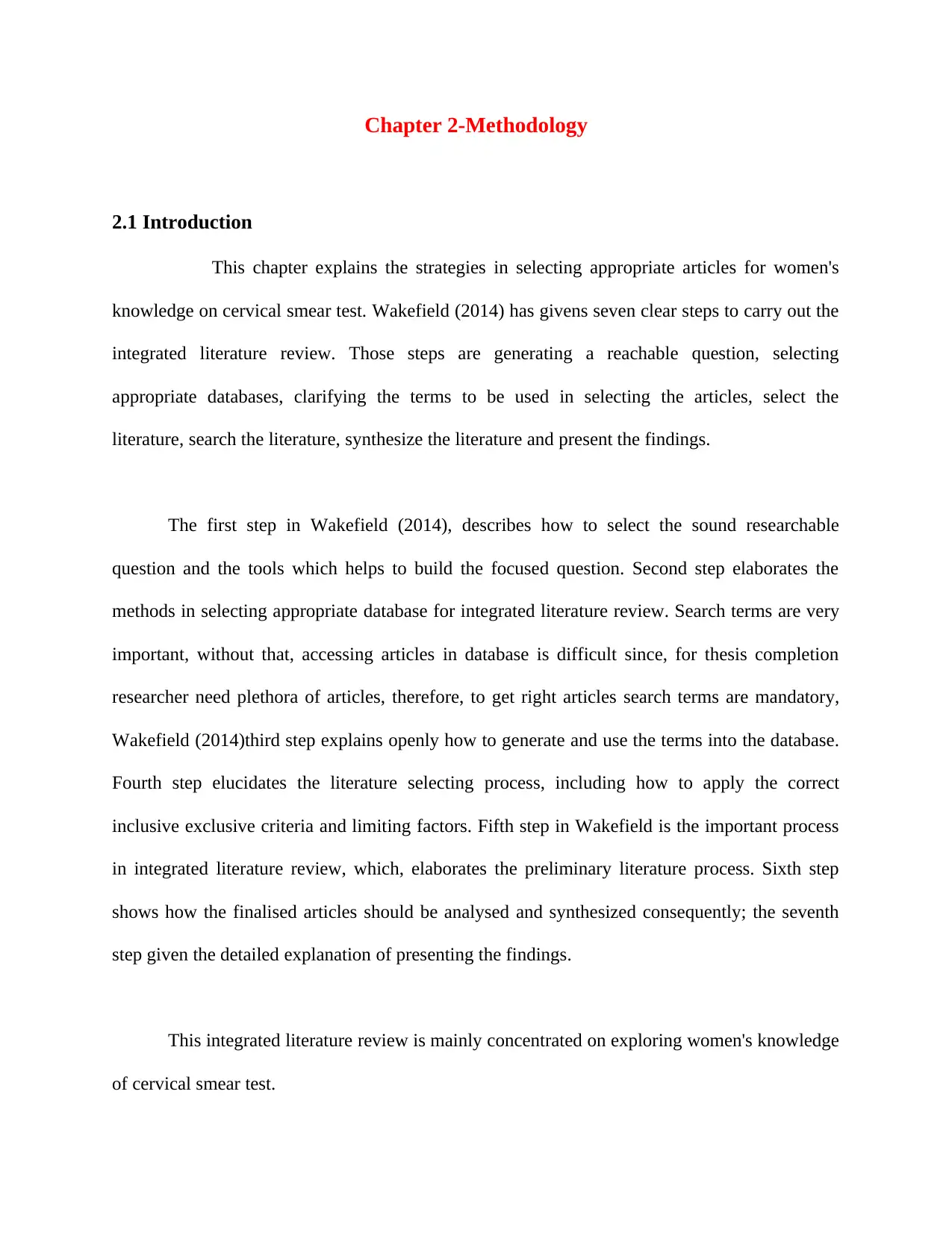
Chapter 2-Methodology
2.1 Introduction
This chapter explains the strategies in selecting appropriate articles for women's
knowledge on cervical smear test. Wakefield (2014) has givens seven clear steps to carry out the
integrated literature review. Those steps are generating a reachable question, selecting
appropriate databases, clarifying the terms to be used in selecting the articles, select the
literature, search the literature, synthesize the literature and present the findings.
The first step in Wakefield (2014), describes how to select the sound researchable
question and the tools which helps to build the focused question. Second step elaborates the
methods in selecting appropriate database for integrated literature review. Search terms are very
important, without that, accessing articles in database is difficult since, for thesis completion
researcher need plethora of articles, therefore, to get right articles search terms are mandatory,
Wakefield (2014)third step explains openly how to generate and use the terms into the database.
Fourth step elucidates the literature selecting process, including how to apply the correct
inclusive exclusive criteria and limiting factors. Fifth step in Wakefield is the important process
in integrated literature review, which, elaborates the preliminary literature process. Sixth step
shows how the finalised articles should be analysed and synthesized consequently; the seventh
step given the detailed explanation of presenting the findings.
This integrated literature review is mainly concentrated on exploring women's knowledge
of cervical smear test.
2.1 Introduction
This chapter explains the strategies in selecting appropriate articles for women's
knowledge on cervical smear test. Wakefield (2014) has givens seven clear steps to carry out the
integrated literature review. Those steps are generating a reachable question, selecting
appropriate databases, clarifying the terms to be used in selecting the articles, select the
literature, search the literature, synthesize the literature and present the findings.
The first step in Wakefield (2014), describes how to select the sound researchable
question and the tools which helps to build the focused question. Second step elaborates the
methods in selecting appropriate database for integrated literature review. Search terms are very
important, without that, accessing articles in database is difficult since, for thesis completion
researcher need plethora of articles, therefore, to get right articles search terms are mandatory,
Wakefield (2014)third step explains openly how to generate and use the terms into the database.
Fourth step elucidates the literature selecting process, including how to apply the correct
inclusive exclusive criteria and limiting factors. Fifth step in Wakefield is the important process
in integrated literature review, which, elaborates the preliminary literature process. Sixth step
shows how the finalised articles should be analysed and synthesized consequently; the seventh
step given the detailed explanation of presenting the findings.
This integrated literature review is mainly concentrated on exploring women's knowledge
of cervical smear test.
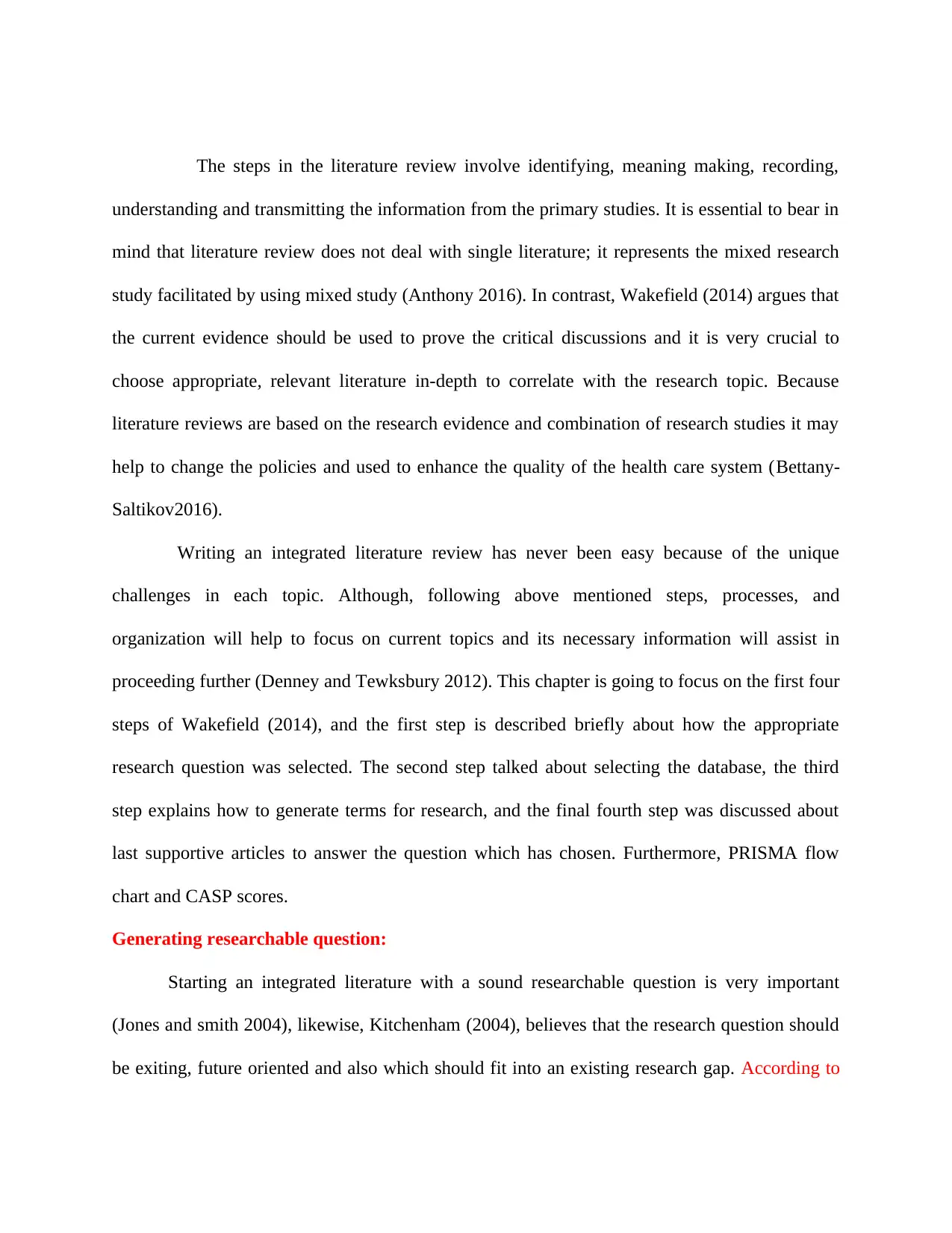
The steps in the literature review involve identifying, meaning making, recording,
understanding and transmitting the information from the primary studies. It is essential to bear in
mind that literature review does not deal with single literature; it represents the mixed research
study facilitated by using mixed study (Anthony 2016). In contrast, Wakefield (2014) argues that
the current evidence should be used to prove the critical discussions and it is very crucial to
choose appropriate, relevant literature in-depth to correlate with the research topic. Because
literature reviews are based on the research evidence and combination of research studies it may
help to change the policies and used to enhance the quality of the health care system (Bettany-
Saltikov2016).
Writing an integrated literature review has never been easy because of the unique
challenges in each topic. Although, following above mentioned steps, processes, and
organization will help to focus on current topics and its necessary information will assist in
proceeding further (Denney and Tewksbury 2012). This chapter is going to focus on the first four
steps of Wakefield (2014), and the first step is described briefly about how the appropriate
research question was selected. The second step talked about selecting the database, the third
step explains how to generate terms for research, and the final fourth step was discussed about
last supportive articles to answer the question which has chosen. Furthermore, PRISMA flow
chart and CASP scores.
Generating researchable question:
Starting an integrated literature with a sound researchable question is very important
(Jones and smith 2004), likewise, Kitchenham (2004), believes that the research question should
be exiting, future oriented and also which should fit into an existing research gap. According to
understanding and transmitting the information from the primary studies. It is essential to bear in
mind that literature review does not deal with single literature; it represents the mixed research
study facilitated by using mixed study (Anthony 2016). In contrast, Wakefield (2014) argues that
the current evidence should be used to prove the critical discussions and it is very crucial to
choose appropriate, relevant literature in-depth to correlate with the research topic. Because
literature reviews are based on the research evidence and combination of research studies it may
help to change the policies and used to enhance the quality of the health care system (Bettany-
Saltikov2016).
Writing an integrated literature review has never been easy because of the unique
challenges in each topic. Although, following above mentioned steps, processes, and
organization will help to focus on current topics and its necessary information will assist in
proceeding further (Denney and Tewksbury 2012). This chapter is going to focus on the first four
steps of Wakefield (2014), and the first step is described briefly about how the appropriate
research question was selected. The second step talked about selecting the database, the third
step explains how to generate terms for research, and the final fourth step was discussed about
last supportive articles to answer the question which has chosen. Furthermore, PRISMA flow
chart and CASP scores.
Generating researchable question:
Starting an integrated literature with a sound researchable question is very important
(Jones and smith 2004), likewise, Kitchenham (2004), believes that the research question should
be exiting, future oriented and also which should fit into an existing research gap. According to
⊘ This is a preview!⊘
Do you want full access?
Subscribe today to unlock all pages.

Trusted by 1+ million students worldwide
1 out of 56
Your All-in-One AI-Powered Toolkit for Academic Success.
+13062052269
info@desklib.com
Available 24*7 on WhatsApp / Email
![[object Object]](/_next/static/media/star-bottom.7253800d.svg)
Unlock your academic potential
Copyright © 2020–2025 A2Z Services. All Rights Reserved. Developed and managed by ZUCOL.